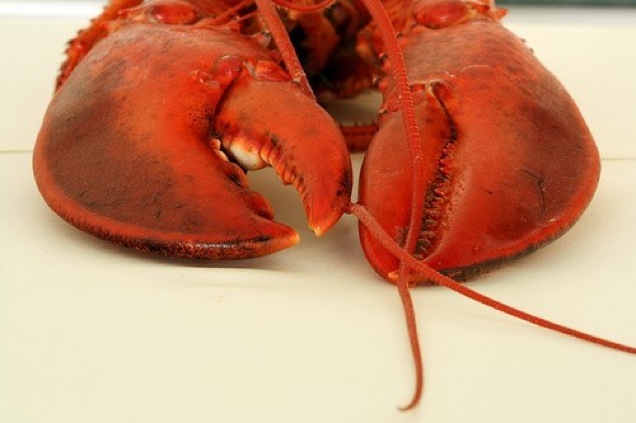
We’d Love To Have
You For Dinner!


heterotrophs, such as water fleas, copepods, crab larvae as well as diatoms, dinoflagellates and filamentous
algae, all of which are protists. Postlarval lobsters (right) feed on the crab and gastropod larvae and fish and copepod eggs. Juvenile and adult lobsters consume smaller shellfish like mussels, clams, and scallops, marine worms like nematodes and polychaetes, sea urchins, and phytoplankton only in stressful times. Typically, after catching prey, lobsters take their prey to their den to eat. As a last resort, lobsters act as scavengers and cannibalism has been seen in captivity.
Lobsters have an extremely varied diet depending on what phase of life they’re in. Larvae, which are considered omnivorous, consume a mixture of autotrophs and
An interesting thing
about lobsters is they
have actually been
known to eat part of
its own molted shell
with the goal of
absorbing the calcium
to strengthen the
formation of the new
shell. To the right is
a photograph of a soft
lobster and its molted
shell.
But it’s not all about the hunt, lobsters are continuously hunted at all life stages. When lobsters are small, the fish are playing the predators. Fish like cod, tench, flounder, sculpin, wolffish, ocean pout, monkfish, and dogfish are serious predators. But as adults, lobster typically only fall prey to humans. Adult lobsters are only vulnerable to predation by other marine life during the molting process, so this is why lobsters tend to molt in the privacy of their own dens.
Here is a link to a great recipe website for lobster delicacies. If humans are considered the lobster’s primary predator, we might as well enjoy the fruits of this labor, while still maintaining the lobster population of course! The edible parts of the lobster are considered to be the muscle, hepatopancreas, gonads and roe. It has been discovered that these edible parts were rich in some or all of the following: Na+ (sodium), Cl- (chlorine), Cu (copper), Zn (zinc), and Se (selenium). However, the contaminant Cd (cadmium) is found at high concentrations in the hepatopancreas, so it is advised that consumption of this tissue is limited! And what better to pair with lobster meat than a lobster mushroom?
Also, please remember that if you plan on eating lobster, the FDA has been cautioning consumers since 2008 to avoid eating the tomalley—the soft green stuff found in the abdomen of the lobster—because it contains high levels of paralytic shellfish poison (PSP) and cooking does not kill this toxin.
For more regarding the nutrition of the American lobster, click here, or learn more about this creature’s friends and frenemies.
Don’t have time to visit everything right now, no problem, just head on back to the main page, and we hope to see you again soon!




